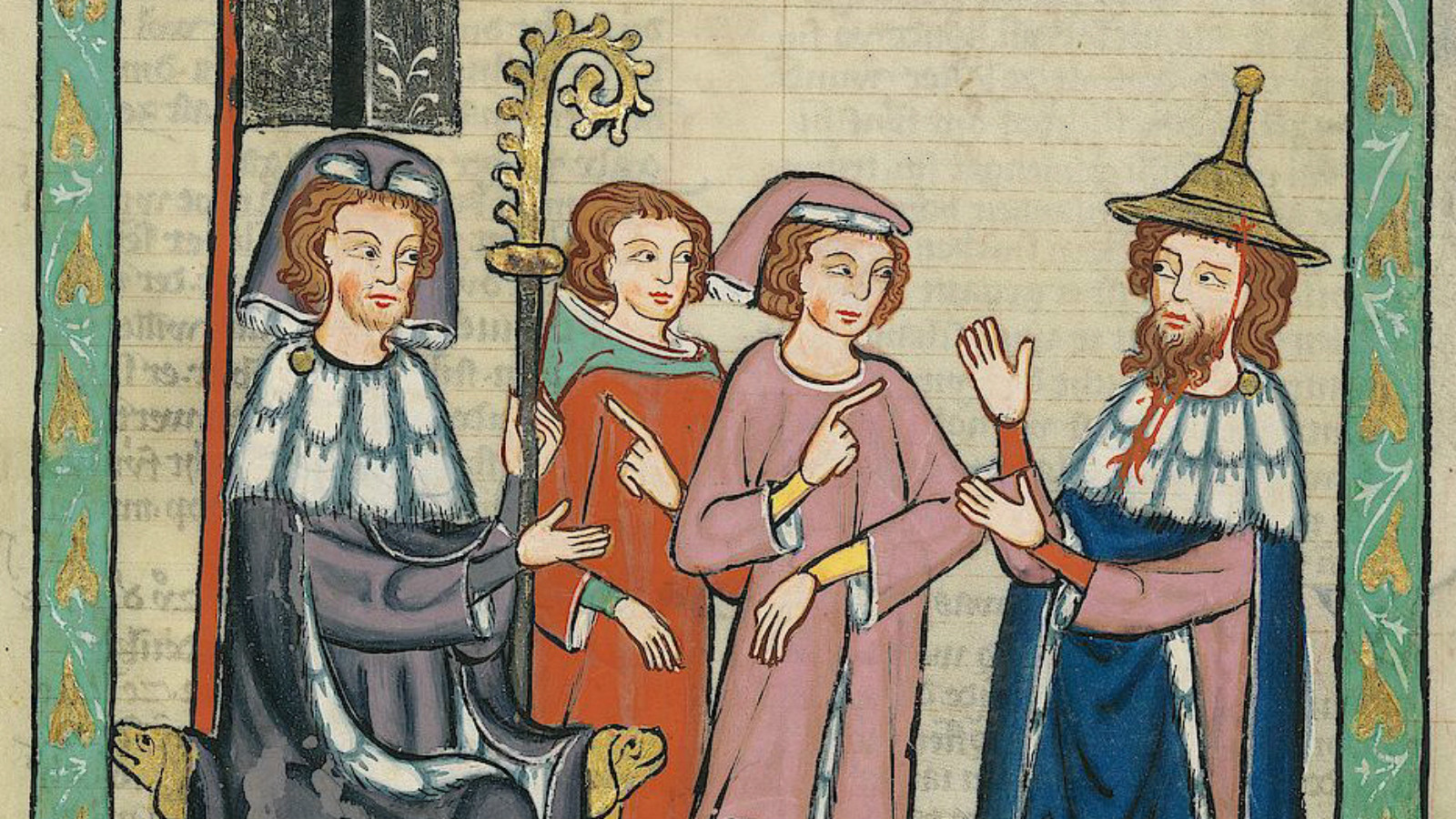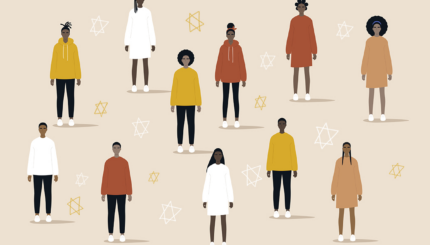Under the spread of Islam (seventh‑-eighth centuries), when the majority of the Jews of the world came under its cultural influence and political control, Jews easily adopted the new styles of dress and were in no way distinguishable from their Muslim neighbors…There is, however, evidence for a requirement that Christians (Jews are not mentioned) wear a distinctive sash (zunnar) and distinctive sign or mark on their headgear and that of their animals. In 850 the caliph al‑Mutawakkil did, in fact, order both Christians and Jews to wear the taylasin, a shawl‑like head covering, and the zunnar.
In Muslim Spain, however, such restrictions were not generally enforced. A particularly fanatical Muslim judge in Seville in the twelfth century attempted to enforce regulations that included, among other things, that Jews and Christians may not dress in the clothing of people of position and must wear a distinguishing sign “by which they are to be recognized to their shame.” Nevertheless, we have certain contemporary evidence from Seville that indicates that these regulations remained theoretical.
In fact, people of the upper classes (and this included most Jews) dressed elegantly in fine silk and linen clothes. These included the jubba, a flowing robe with large sleeves and of various colors depending on taste, such as green, orange, or rose. Women as well as men wore this, and women also wore the qamis, a fine tunic of transparent gauze.
Veils were not common for women, and in fact in the early Muslim period were worn more by men. This is incidentally confirmed by ibn Ezra, who wrote that the veil is a long, thin piece of cloth covering the head and is worn by women only in a few places; “for in the land of Ishmael [Arabia], Spain, Africa, Egypt, Babylon and Baghdad [!] it is worn on the head by distinguished men and not by women” (commentary on Ex. 29.36). [Abraham ibn Ezra (1089-1164) was a Spanish poet, philosopher and biblical exegete.]

Help us keep Jewish knowledge accessible to millions of people around the world.
Your donation to My Jewish Learning fuels endless journeys of Jewish discovery. With your help, My Jewish Learning can continue to provide nonstop opportunities for learning, connection and growth.
Caps and Colors, Bells and Calves
In Muslim Spain until the thirteenth century the turban was customarily worn by men, including Jews, but was abandoned after that except for certain provinces. The turban was gradually replaced by a woolen cap, usually green or red, and the Jews often wore yellow. The Jews of Muslim North Africa generally continued to wear turbans. In Egypt, ca. 1005, the fanatical caliph al‑Hakim ordered Jews and Christians to wear black robes, and in the public baths Christians had to wear iron crosses around their necks, and Jews bells (in the street they were required to wear a wooden image of a calf, in “memory” of the biblical golden calf). This obligation with regard to wearing bells while in the baths had earlier precedents. However, these rigid ordinances were not strictly enforced and were apparently soon forgotten.
In fact, Jews, both men and women, continued to dress in lavish apparel. There were Jewish makers and sellers of clothes, including secondhand, in Egypt, and if we hear of few such in at‑Andalus at least there were merchants engaged in the silk trade and import of textiles.
Christian Europe –Rabbis Prefer Black
Rabbinic sources always need to be used with some caution, since they tend to express the most conservative views. On the basis of some of these it has been stated, for instance, that Jews in Germany eschewed bright colors, preferring dark or even black. However, manuscript illustrations from Germany (13th through the 15th centuries) do not support this. The standard clothing for men was a robe reaching to just below the knees, and at times (probably to protect from the cold) this was covered by a cloak no different from those worn by Christians, which was fashioned with a broach. The colors of the robes and cloaks were red, blue, green, or yellow, sometimes tan.
A special garment worn only for holidays was the sargenes, or kittel, which was a broad robe or cloak with the right side sewn up to prevent carrying. It became customary to wear this garment on the Sabbath (although the community ordinances of Speyer, Worms, and Mayence had earlier prohibited the wearing of this garment in the synagogue on Sabbaths). From other sources it appears that this was also the garment used for burying the dead, and possibly because of this it became customary to wear it also on (even now many traditional Jews wear a thin white robe, which is also called a kittel on Yom Kippur and at the Passover seder).
While many of the manuscript illuminations portray either biblical characters, albeit in contemporary costume, or Jews celebrating a holiday or in the synagogue, some few show more mundane examples of working Jews, men and women, or on horseback, and in such scenes may be seen the more typical daily clothing worn for working purposes. Again, there is no distinction between this and the similar clothing worn by Christians. Some of the aforementioned French manuscripts (not by Jewish artists) portray Jewish men in long, flowing robes of various mixed bright colors (red‑orange, forest green, yellow‑tan, and some light gray), with hose of contrasting colors.
Spain vs. Ashkenaz: A Loopy Question
In Spain an outer garment was worn that was open on the sides and had loops through which a belt was fastened. Similarly, Meir b. Barukh of Rothenburg had been asked about the permissibility of wearing trousers fastened by a belt on the Sabbath. He also disapproved of the custom of attaching a house key to a piece of metal as adornment on a belt on the Sabbath, since this would be carrying (even though he admits that some allowed this). [Rabbi Meir of Rothenburg (ca.1220-1293) was the foremost talmudic and legal authority of his time.]
You Can Wear Furs Anywhere
Jews in Spain, men and women, wore fairly luxurious clothing, often adorned with gold or jewel ornaments. However, early depictions, such as the illustrations of the thirteenth‑century Cantigas de Santa Maria, show Jews dressed little differently from those of France and Germany; however, as noted above, these were by artists of non‑Spanish origin. Also in late medieval Italy, particularly in the north, Jews were lavish in their costume, with fur‑trimmed garments and cloaks, luxurious cloth, and often with hose of contrasting colors for the men.
Shoes were usually of leather (in Germany one of the rabbis was asked about the permissibility of making shoes from hides originally intended for scrolls). In an interesting responsum, Ibn Adret was asked if it were permitted to wear patines in the street on the Sabbath, a word that seems to refer to a wooden shoe or shoe with cork soles to prevent slipping on the ice (in modern Spanish it means “skates,” but the medieval term used is akin to a French or Lombard word), to which he replied that it is the custom of “all the wise of the land” to wear them and is certainly permitted. [Solomon b. Abraham Ibn Adret, the RaShbA (ca. 1233-ca.1310) was one of the greatest Spanish rabbinic authorities in the Middle Ages.]
Reprinted with permission from the author.



